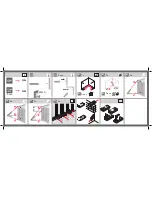
5. Maintenance
NOTE:
All
factory
repairs
and
recalibrations
require
a
returned
material
authorization
(RMA
number
and
completion
of
the
“Statement
of
Product
Cleanliness
and
Decontamination”
form.
Refer
to
the
page
at
the
front
of
this
document
for
more
information.
5.1 Periodic maintenance schedule
Perform routine maintenance on the WEATHERPAK M every 12 to 24 months to ensure that the
overall system and its sensors are within specification. In addition, the entire WEATHERPAK M
should be examined for wear, damage, or other non-conforming variances.
5.2 Troubleshooting
CAUTION:
Taking the WEATHERPAK M or the
WEATHERPAK M
display apart will void the warranty. If the
following procedures do not solve the problem, contact Campbell Scientific (see
).
When completely assembled, the WEATHERPAK M system automatically powers up, locates True
North, and begins sampling the atmospheric conditions; it then transmits weather data every 30
seconds. If it does not, check the following:
l
Confirm the WEATHERPAK M is properly secured in the cam lock connector on the tripod
base.
l
Check the batteries in the tripod. The red LED voltage indicator light on the tripod base will
remain illuminated when the battery voltage is higher than 10.7 VDC. If the LED indicator is
not illuminated or if it is flashing, replace the batteries with fresh alkaline D-cells. When
replacing tripod batteries, use only high-quality alkaline batteries.
CAUTION:
Do not use rechargeable or bargain batteries.
l
Check the fuse. The in-line fuse holder is in the junction box at the top of the tripod base.
Access the fuse by removing the two screws on the junction box cover. If the fuse is blown,
replace with an AGC 3 fuse. If the fuse blows repeatedly, contact Campbell Scientific. See
Replacing tripod batteries and fuse
WEATHERPAK M
29









































